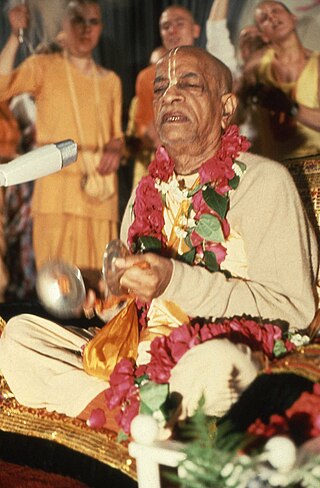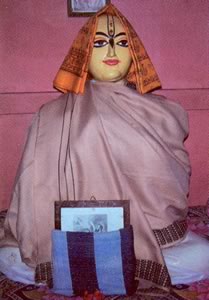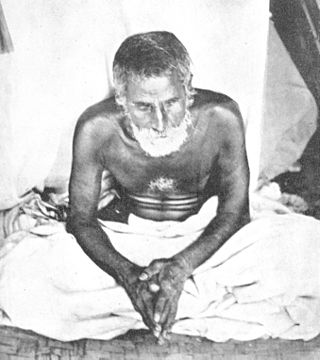Related Research Articles

Abhay Charanaravinda Bhaktivedanta Swami was an Indian Gaudiya Vaishnava guru who founded ISKCON, commonly known as the "Hare Krishna movement". Members of ISKCON view Bhaktivedanta Swami as a representative and messenger of Chaitanya Mahaprabhu.

Chaitanya Mahaprabhu was a 15th-century Indian saint who is considered to be the combined avatar of Radha and Krishna by his disciples and various scriptures. Chaitanya Mahaprabhu's mode of worshipping Krishna with ecstatic song and dance had a profound effect on Vaishnavism in Bengal. He was also the chief proponent of the Vedantic philosophy of Achintya Bheda Abheda Tattva. Mahaprabhu founded Gaudiya Vaishnavism. He expounded Bhakti yoga and popularized the chanting of the Hare Krishna Maha-mantra. He composed the Shikshashtakam.

Bhaktisiddhanta Sarasvati, born Bimala Prasad Datt, was a Gaudīya Vaisnava Hindu guru, ācārya, and revivalist in early 20th century India. To his followers, he was known as Srila Prabhupāda.

Gaudiya Vaishnavism, also known as Chaitanya Vaishnavism, is a Vaishnava Hindu religious movement inspired by Chaitanya Mahaprabhu (1486–1534) in India. "Gaudiya" refers to the Gaura or Gauḍa region of Bengal, with Vaishnavism meaning "the worship of Vishnu". Specifically, it is part of Krishnaism—Krishna-centric Vaishnavite traditions.

Bhaktivinoda Thakur, born Kedarnath Datta, was a Hindu philosopher, guru and spiritual reformer of Gaudiya Vaishnavism who effected its resurgence in India in late 19th and early 20th century and was hailed by contemporary scholars as the most influential Gaudiya Vaishnava leader of his time. He is also credited, along with his son Bhaktisiddhanta Sarasvati, with pioneering the propagation of Gaudiya Vaishnavism in the West and its eventual global spread.
The Chaitanya Charitamrita, composed by Krishnadasa Kaviraja in c. 1557, is written in Bengali with a great number of Sanskrit verses in its devotional, poetic construction, including Shikshashtakam. It is one of the primary biographies detailing the life and teachings of Caitanya Mahāprabhu, the founder of Gaudiya Vaishnavism. The stories of Chaitanya's life are mixed with philosophical conversations detailing the process of Bhakti yoga, with special attention given to congregational chanting of Krishna's names and the Hare Krishna mantra.

The Gaudiya Math is a Gaudiya Vaishnava matha formed on 6 September 1920, about 30 months after Bhaktisiddhanta Sarasvati took sannyasa, the renounced order of life. On 7 March 1918, the same day he took sannyasa, he established the Sri Chaitanya Math in Mayapura in West Bengal, later recognised as the parent body of all the Gaudiya Math branches. Its purpose was to spread Gaudiya Vaishnavism, the philosophy of the medieval Vaisnava saint Chaitanya Mahaprabhu, through preaching and publishing.

Bhakti Hridaya Bon, also known as Swami Bon, was a disciple of Bhaktisiddhanta Sarasvati and a guru in the Gaudiya Math following the philosophy of the Bhakti marg, specifically of Caitanya Mahaprabhu and Gaudiya Vaishnava theology. At the time of his death, he left behind thousands of Bengali disciples in India.
Walther Eidlitz, also known as Vāmana Dāsa, was an Austrian writer, poet, Indologist and historian of religion.

Haridasa Thakur was a prominent Vaishnava saint known for being instrumental in the initial propagation of the Hare Krishna movement. He is considered to be the most famous convert of Chaitanya Mahaprabhu, apart from Rupa Goswami and Sanatana Goswami. His story of integrity and unflinching faith in the face of extreme adversity is told in Chaitanya Charitamrita, Antya lila. It is believed that Chaitanya Mahaprabhu himself designated Haridasa as nāmācarya, meaning the 'teacher of the Name'. Haridasa Thakura, was a devotee of God, Krishna, and had practiced chanting the names of the Lord, Hare Krishna, 300,000 times daily.

Bhakti Prajnan Keshava, addressed by the honorific Mahārāja, was a Gaudiya Vaishnava guru, disciple of Bhaktisiddhanta Sarasvati and the founder-acharya of the religious organisation "Sri Gaudiya Vedanta Samiti", formed in Calcutta in 1940, and its headquarters, monastery Sri Devananda Gaudiya Math in Nabadwip.

Bhaktivedanta Tripurari, also known as Swami BV Tripurari and formerly as Tripurari Swami, is an American author, poet, and guru, described as "a prominent master in the Gaudiya Vaishnava lineage", and "one of the leading practitioners of Bhakti-yoga in the West".

An ISKCON guru is a person who is permitted to initiate disciples into the International Society for Krishna Consciousness system. The guru system has undergone several changes and reform since its beginnings in the 1960s. Upanayana as a traditional "sacred thread ceremony" of the Gayatri Mantra, commonly known Hindu Samskara, is complemented by Pancaratric mantras of the Gaudiya Vaishnava sampradaya and follows the principal initial nama initiation ceremony, referred to respectively as brahmana diksa and Hari nama diksa.

Sri Devananda Gaudiya Math is situated at Teghori Pada in Nabadwip dham of district Nadia in the West Bengal state of India, and is a matha and prominent holy place of the Gaudiya Vaishnavas, as well the headquarters of the Sri Gaudiya Vedanta Samiti. It is located in the middle of the place earlier known as Koladvipa. The Math has been continuing as a famous religious spot thronged by thousands of devotees every year.

Gaurakisora Dasa Babaji is a well-known acharya from the Gaudiya Vaishnava tradition of Hinduism, and is regarded as a Mahatma or saint by followers of his lineage. During his lifetime Gaurakisora Dasa Babaji became famous for his teachings on the process of Bhakti Yoga and for his unorthodox avadhuta like behaviour as a sadhu, or babaji in Vrindavan.

Ferdinando Sardella, born 1960, is a Swedish scholar of the history of religions, Hinduism, and religious studies, the former director and coordinator of the Forum for South Asia Studies at Uppsala University.
This is a list of works by Bhaktisiddhanta Sarasvati (1874-1937), a Gaudiya Vaishnava leader and religious reformer. This list includes his original works, commentaries on canonical Vaishnava texts, and articles in periodicals Sajjana-toshani and the Gaudiya.

The Gaudiya Mission is a Gaudiya Vaishnava monastic and missionary organization whose founder acharya is Srila Prabhupad alias Srimad Bhakti Siddhanta Sarasvati Goswami Maharaja. The organisation has been registered since March 1940 in Calcutta, British India under the supervision of the then Acharya Srila Acharyadev alias Srimad Bhakti Prasad Puri Goswami Maharaj after accepting sannyasa in 1939/1941.

Bhakti Rakshak Sridhar was an Indian guru, writer, sannyasi and spiritual leader in the Gaudiya Vaishnava tradition of Chaitanya Mahaprabhu, founder-president-acharya of the Sri Chaitanya Saraswat Math.

Kṛṣṇa-Caitanya, The Hidden Treasure of India: His Life and His Teachings is the main work of the Austrian scientist and guru of Gaudiya Vaishnavism Walther Eidlitz (1892-1976).
References
- Bon Maharaja, Tridandi Swami Hridaya (1933), My lectures in England and Germany. Vrindaban and Calcutta: Messers N. K. Banerjee.
- Eidlitz, Walther (1952). Unknown India. A Pilgrimage into a forgotten World. New York: Rider & Company.
- Eidlitz, Walther (1968). Krishna-Caitanya. Sein Leben und Seine Lehre . Stockholm: Almkvist & Wiksell.
- Ramdas, Swami (1940). In the Vision of God. Kanhangad: Anandashram.
- Rosen, Steven (1992), Vaiṣṇavism: contemporary scholars discuss the Gauḍīya tradition, Folk Books, ISBN 0-9619763-6-5
- Sardella, Ferdinando (2010). Bhaktisiddhanta Sarasvati. The Context and Significance of a Modern Hindu Personalist. Gothenburg: University of Gothenburg.
- Stamm, Katrin (2017), Be Careful with Bhakti or Why the Guru withdraws: The Unconventional Life and Teachings of Svami Sadananda Dasa. Journal of Vaishnava Studies. Spring 2017, Vol 25, p. 131-150.
- Veltheim-Ostrau, Hans-Hasso von (1956), Tagebücher aus Asien. Teil 1. Bombay, Kalkutta, Kashmir, Afghanistan, Die Himalayas, Nepal, Benares: 1935 - 1939., Hamburg: Claassen